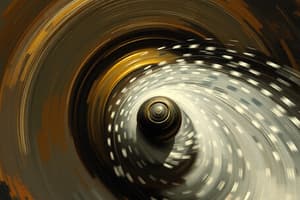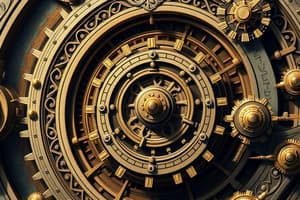Podcast
Questions and Answers
What is the key difference between torques and moments in mechanics of materials?
What is the key difference between torques and moments in mechanics of materials?
- Torques and moments have different units of measurement.
- Torques are static loads, while moments are associated with movement.
- Torques create rotation around the axis, while moments affect the axis of the member being analyzed. (correct)
- Torques and moments have the same effect on materials under torsion.
What is the expression for calculating the maximum shearing stress in a rod subjected to torsion?
What is the expression for calculating the maximum shearing stress in a rod subjected to torsion?
- tc/j (correct)
- j/tc
- tc
- tc*j
How is the shearing stress profile in a rod subjected to torsion described?
How is the shearing stress profile in a rod subjected to torsion described?
- Sinusoidal
- Constant
- Linear (correct)
- Exponential
What role do shearing stresses and shearing modulus play in understanding material behavior under torsion?
What role do shearing stresses and shearing modulus play in understanding material behavior under torsion?
How can the direction of rotation in members under torsion be indicated?
How can the direction of rotation in members under torsion be indicated?
How are internal torques in shafts calculated for better understanding?
How are internal torques in shafts calculated for better understanding?
What units are used to measure both torques and moments in physics?
What units are used to measure both torques and moments in physics?
Flashcards are hidden until you start studying
Study Notes
- Torque in physics is associated with movement or rotation, while moments are static loads with no rotation.
- Both torques and moments have the same units: newton meters in metric and pound inches/pound feet in English units.
- In mechanics of materials, the difference lies in torques affecting the axis of the member being analyzed.
- Torques are applied to the axis of the member, while moments do not create rotation around the axis.
- Shearing stresses and shearing modulus play a key role in understanding the behavior of materials under torsion.
- The shearing stress profile in a rod subjected to torsion is linear, with maximum stress at the surface.
- The expression for maximum shearing stress (tau max) in a rod is given by tc/j, where j is the polar second moment of area.
- The polar second moment of area (j) can be calculated for solid rods and hollow rods with different expressions.
- Internal torques in shafts can be calculated using cuts and labeled with sub-indices for better understanding.
- The direction of rotation in members subjected to torsion is indicated by positive (counterclockwise) and negative (clockwise) values of torques.
Studying That Suits You
Use AI to generate personalized quizzes and flashcards to suit your learning preferences.




